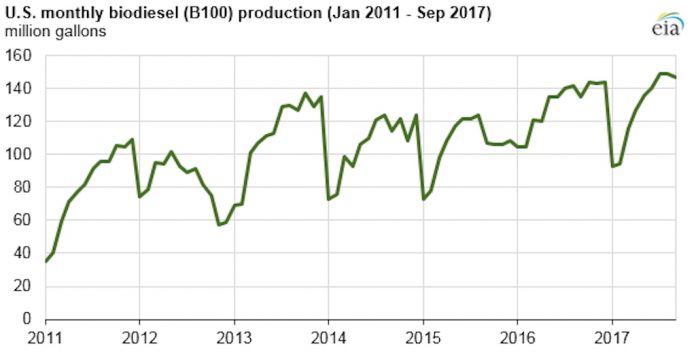WASHINGTON — Through the first nine months of 2017, U.S. biodiesel production levels were slightly higher than 2016 levels, despite the expiration of a federal biodiesel blender’s tax credit at the end of 2016.
And according to experts at the U.S. Energy Information Administration, domestic biodiesel production may continue to increase because of changes to import policies such as those recently announced by the U.S. Department of Commerce on biodiesel imports from Argentina and Indonesia.
Tax incentives
Biodiesel production increased over time largely because of state and federal incentives. The federal biodiesel blender’s tax credit, valued at $1 per gallon, expired several times prior to 2016, most recently at the end of 2014. In those earlier years, Congress ultimately voted to reinstate the tax credit retroactively.
Biodiesel qualifies as an advanced biofuel as part of the Renewable Fuel Standard (RFS), a program implemented by the U.S. Environmental Protection Agency to promote the incorporation of biofuels into the nation’s fuel supply.
To demonstrate compliance with the RFS, refiners and importers of petroleum products must either blend advanced biofuels such as biodiesel or buy credits called renewable identification numbers (RINs).
Biodiesel is often combined with petroleum diesel in blends ranging from 5 percent to 20 percent biodiesel.
On average, biodiesel accounted for about 4 percent of total diesel consumption in 2016.
Similar to corn ethanol, biodiesel production is concentrated in the Midwest and delivered by rail and truck across the country.
Biodiesel imports
Since 2014, foreign biodiesel imports — primarily from Argentina and Indonesia — have increased in the East Coast and Gulf Coast regions.
In 2016, biodiesel imports from Argentina reached 449 million gallons and accounted for nearly 20 percent of U.S. biodiesel consumption.
However, in April 2017, the U.S. Department of Commerce (DOC) initiated two investigations into whether biodiesel imports from Argentina and Indonesia put U.S. biodiesel producers at a disadvantage.
The two investigations have focused on countervailing duties — when a foreign government provides subsidies for the production of a product — and antidumping — when a foreign government sells a product at less than its fair value.
In November, the DOC issued an affirmative final determination on countervailing duties for Argentina and Indonesia, assigning rates ranging from 34 percent to 72 percent, based on the producer or importer of biodiesel.
The U.S. International Trade Commission reached a similar finding in December, allowing for DOC to issue final countervailing duty orders.
Depending on the outcome of the antidumping investigation, the combined effect of the final orders may more than double the price of biodiesel from these two countries.
In response to the investigations, new U.S. contracts for cargos of biodiesel from Argentina and Indonesia have slowed, and imports from these countries are likely to remain low unless a settlement is reached or U.S. biodiesel prices rise to offset the final duties.
* * *
US biodiesel by the numbers
- U.S. biodiesel consumption in 2016 totaled 2,189 million gallons, of which 1,569 million gallons (72 percent) were produced domestically.
- U.S. biodiesel facilities ran at 69 percent of nameplate capacity during 2016. As of September 2017, U.S. biodiesel production capacity stands at 2,348 million gallons.
- Biodiesel is typically more expensive than petroleum-based diesel, so the loss of lower-cost imports from Argentina and Indonesia might further decrease its price competitiveness.
- During 2016, the average spot price of Gulf Coast biodiesel was $3.17/gal, which was $1.85/gal higher than its petroleum counterpart.
(Source U.S. Energy Information Administration)










